Psychology - Chapter 14, Psychological Disorders
1/28
There's no tags or description
Looks like no tags are added yet.
Name | Mastery | Learn | Test | Matching | Spaced |
|---|
No study sessions yet.
29 Terms
What is abnormal: The role of culture
Cultural concepts of distress:
A pattern of mental illness, distress, and/or symptoms that is unique to a specific ethnic or cultural population
Does not conform to standard classifications of psychiatric disorders
Some behaviours are not culturally specific
Ex. Schizophrenia, bipolar disorder, panic disorder - biological bases
(May have different meanings across cultures)
Koro:
An episode of sudden illness and intense anxiety that the genitals recede into the body and possibly causes death
(Chinese, Malaysian, and Indonesian)
Amok Syndrome:
Period of brooding followed by a sudden outburst of indiscriminate murderous frenzy, sometimes provoked by an insult, jealousy, or a sense of depression
(Brunei, Singapore, Malaysia, Indonesia, Philippines, Timor-Leste)
4 D’s (actually 5 lol)
Deviance
Departure of what is normal/usual
Refers to behaviours, thoughts, and feelings that are not in line with generally accepted standards
Culturally - based
Distress
Behaviors, thoughts, and feelings that are upsetting and cause pain, suffering, or sorrow
Dysfunctional
Behaviors, thoughts, and feelings are disruptive to one’s regular routine or interfere with day-to-day functioning
Dangerous
Behaviors, thoughts, and feelings may head to harm or injury to self or others
Duration
The interval between the onset of a psychiatric disorder and the administration of the first pharmacological treatment
(to get a diagnosis, the abnormal behaviours need to persist for a specific amount of time)
Psychological disorder:
Patterns of deviant and dysfunctional behaviors, thoughts, and/or feelings that cause significant dishes, and may even be dangerous, and last for a specific amount of time.
History of Psychiatry: 1840
First attempt in the US to gather info. about mental health (ideas of idiocy and insanity)
History of Psychiatry: 1883
Emil Kraplin
Published a system of psychological disorders centered around a pattern of symptoms
7 categories:
Mania
Melancholia
Monomania
Paresis
Dementia
Dipsomania
Epilepsy
History of Psychiatry: 1918
America Medico-Psychological Association changed its name to the American Psychological Association (APA)
Issued the statistical manual for use of institutions for the insane
(Beg. of Diagnostic Materials)
First Diagnostic Manuals
1921: Americana Medical Association’s standard Classification Nomenclature of Disease
22 different categories, 21 psychotic conditions
History of Psychiatry: 1946
US army psychiatrists following WW2
High proportion of soldiers in combat suffered psychiatric breakdowns
Kinds of breakdowns they had (clearly response to stressful experiences) weren’t encompassed by existing manual (in-patients)
Model for first DSM
Diagnostic and statistical manual for mental disorders (DSM-I) 1952
Combined 2 major influences:
Adolf Meyer → emphasized how most mental disorders represented personality reactions to psychological, social, and biological factors
Sigmund Freud → general underlying processes rather than outward symptoms
- Unreliable diagnostic tool, but the first tool to focus on clinical use
- Concepts had not been scientifically tested
- 10 Categories for psychoses and psychoneuroses
- 7 Categories for disorders of character, behavior, and intelligence
Diagnostic and statistical manual for mental disorders (DSM-II): 1968
193 personality disturbance
Based on psychoanalytic theory
Unreliable diagnostic tool - didn’t pay a lot of attention to symptoms of some conditions, much more general in their outlook
Eliminated the term reaction but kept the term neurosis
Increased attention to children and adolescents is not seen in the previous version
Diagnosis of homosexuality renamed “sexual orientation disturbance”
Diagnostic and statistical manual for mental disorders (DSM - III): 1980
Why?
Research psychiatrists
Consistent diagnostic criteria across different clinicians
Pharmaceutical industry
Products originally marketed for general conditions, not particular diagnoses
This changed in the 1970s, when the FDA (US regulatory board) could no longer advertise their products for the “stress of life” (common marketing technique)
Needed to prove effectiveness with particular conditions (Concrete, measurable
Third-party health insurance
In the 50’s, most patients paid out of pocket for therapists
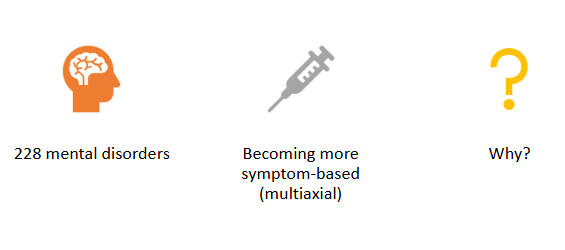
Diagnostic and Statistical manual for mental disorders (DSM-III): 1980
Included explicit diagnostic criteria
Goal: standardized diagnostic reliability (better treatment, randomized clinical trials became easier)
Becoming multiaxial
Multiaxial: a system/method of evaluation, grounded in the biopsychosocial model of assessment that considers multiple factors in mental health diagnoses
Responsible for the shift to biological psychiatry
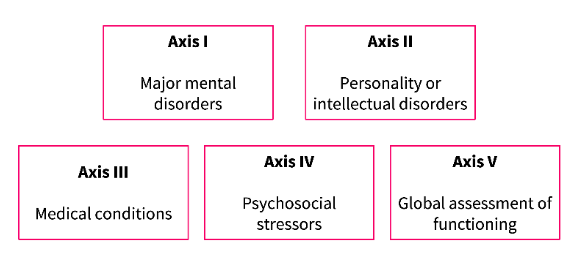
Medical model
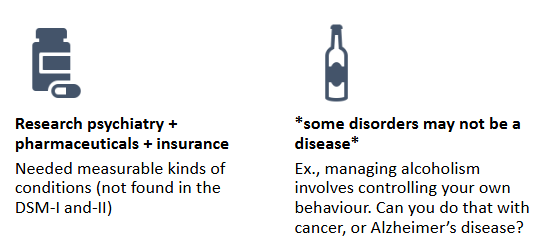
Diagnostic and statistical manual for mental disorders (DSM - III - R): 1987
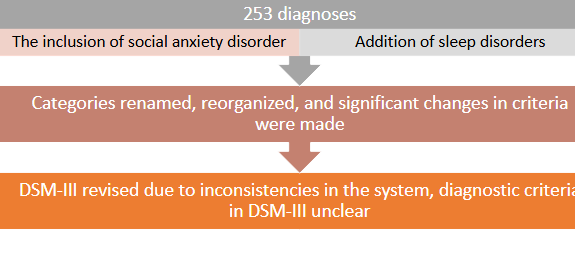
DSM-III to DSM-III-TR
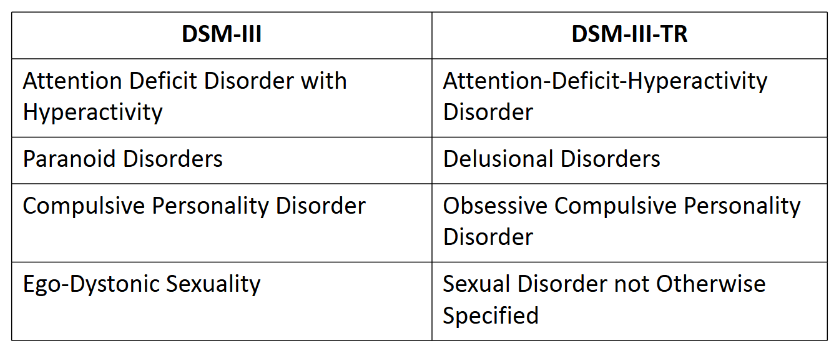
Diagnostic and statistical manual for mental disorders (DSM-IV): 1994
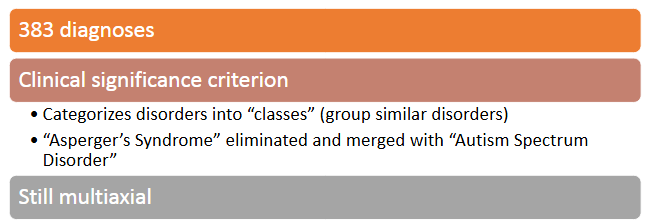
Diagnostic and statistical manual for mental disorders (DSM-IV-TR): 2000
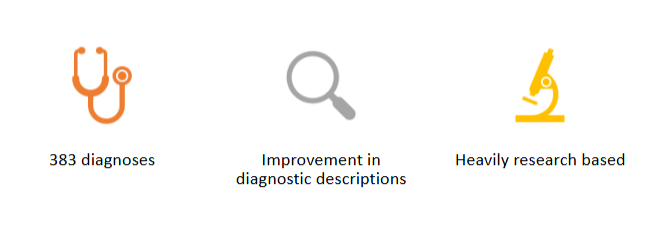
Diagnostic and statistical manual for mental disorders (DSM-V): 2013
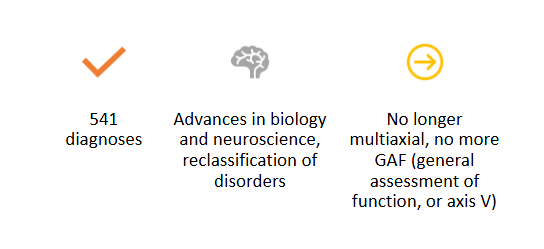
DSM-IV-TR to DSM-V
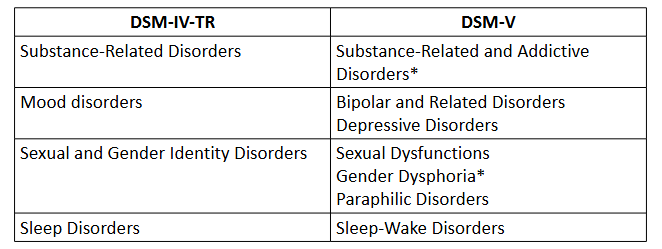
Diagnostic and statistical manual for mental disorders (DSM-V-TR): 2022
Identified out-of-date information in the DSM-V
Clarified certain diagnostic criteria
Ensured appropriate attention to risk factor (racism, discrimination)
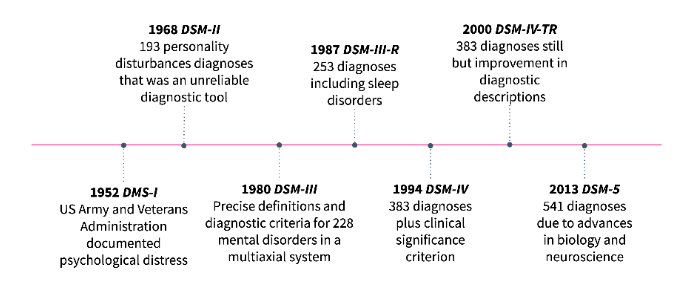
Other diagnositc manuals
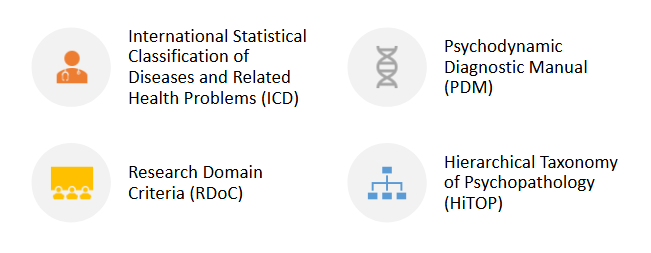
Anxiety Disorders
Fear and anxiety are adaptive reactions to threats
Ex. It is typical to be fearful of a hungry lion or anxious about an upcoming exam
Estimated 30% of Canadians experience one pathological anxiety, although only about 5% of people are ever diagnosed.
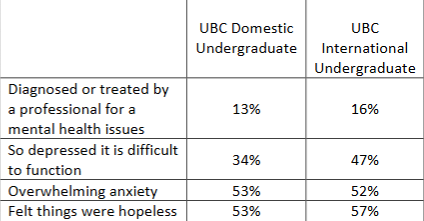
DSM-5 recognizes 12 types of anxiety disorders:
Generalized Anxiety Disorder (GAD
An anxiety disorder in which worries are not focused on any specific threat - GAD is used as a case study for examining the different parts of the DSM
In the population, levels of anxiety are constant throughout the lifespan - the content of worries changes
Diagnostic Criteria:
Excessive anxiety and worry, occurring more days than not for at least 6 months, about more than one event/stressor
The individual finds it difficult to control the worry
Three or more of these symptoms:
a) Restlessness
b) Fatigue
c) Concentration deficiency
d) Irritability
e) Muscle tension
f) Sleep disturbanceCauses significant distress/affects functioning
Cannot be attributed to substance use or other medical condition
Cannot be better described by another DSM diagnosis
Onset:
Median age for diagnosis is 30, but many patients report having anxiety symptoms for a long time before reporting them
In the population, the level of anxiety is constant throughout life spans
The content of worries changes
Prognosis: In individuals, the severity of symptoms waxes and wanes across the lifespan (remission is rare)
Phobic Disorders
A more specific type of anxiety disorder (characterized by marked, persistent, excessive fear of specific objects, activities, or situations)
Usually, the person recognizes the irrationality of their fear but can’t control it
Specific phobias: Have 12% prevalence
Animals
Natural environment
Situations
Medical events
Other
Social phobia - maladaptive fear of being publicly humiliated or embarrassed (13% prevalence)
Why are phobic disorders so common? Preparedness Theory
We may be evolutionarily adapted to fear certain types of stimulus
Evidence for this hypothesis comes from conditioning
Monkeys can easily be conditioned to fear snakes, but not flowers
These fears may be overdeveloped in some individuals
Panic Disorder
Sudden occurrence of multiple psychological and physical symptoms typically associated with terror
Shortness of breath
Heart palpitations
Sweating
Dizziness
derealisation (feeling that the world is unreal)Fear of death/”losing one’s mind?
Panic episodes are common (1/3 Canadian experience a panic attack once or more per year)
Diagnosis:
Recurrent, unexpected attacks
Significant fear of another attack